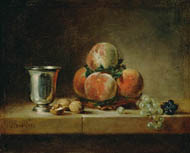• Image of Still Life with Peaches, a Silver Goblet, Grapes, and Walnuts by Jean-Siméon Chardin
• Image of Still Life with Fruit and Decanter by Roger Fenton
• Diagram 1 (diagram of shapes in Chardin still life)
• Diagram 2 (diagram of shapes in Fenton still life)
• Diagram 3 (diagram of composition of Chardin still life)
• Looking at Still Life Student Worksheet 2
• Looking at Still Life Student Worksheet 3
• Realia to demonstrate geometric shapes (optional)
• Cutouts of geometric shapes such as circles, squares, triangles, etc. (optional) |
 |
 |
 |
• Explain that artists throughout time have used basic shapes in their works, and that combinations of these shapes are often employed to create still-life compositions. (Note: shapes are flat [two-dimensional], but can create the illusion of three dimensions.)
• Draw, or ask students to draw, the five basic shapes on the board—a circle, oval, square, rectangle, and triangle.
• Display Still Life with Peaches, a Silver Goblet, Grapes, and Walnuts.
• Point out the shapes that are present in the painting. Introduce the shape vocabulary to the students. Use the Diagram 1 to help explain that the Chardin painting has circles (peaches and grapes), ovals (walnuts), rectangles (the ledge), and a triangle (the stacked peaches).
• Employ early production strategies to help students use this vocabulary:
1. Ask yes/no questions (Is this a circle?)
2. Ask or questions (Is this a circle or an oval?)
3. Ask wh- questions (What shape is the ledge?)
4. Make open-ended statements (The peaches are shaped like . . .)
• Write the vocabulary on the board.
STUDENT WORKSHEETS
• For practice with shapes, use Student Worksheet 2. Distribute the worksheet to students. Display Still Life with Fruit and Decanter. Ask students to draw the shapes they see in the artwork on the photocopy, using a colored pen or marker. Use Diagram 2 to help explain that the Fenton photograph has ovals (the basket and pineapple), circles (the peaches and grapes), a rectangle (the decanter), and a triangle (the overall construction of the scene). Afterwards, have students list the names of the shapes and the objects that form those shapes.
• For practice with composition, use Student Worksheet 3. Distribute the worksheet to students. Display Still Life with Peaches, a Silver Goblet, Grapes, and Walnuts. Explain to students that sometimes the overall composition of an artwork is a series of shapes. Use Diagram 3 to help explain that the Chardin painting is a series of triangles on a rectangular base. Have students follow the worksheet instructions in order to find these shapes and to look at repeated shapes.
SUGGESTED ACTIVITIES
• Using cutouts of different shapes, have students construct their own geometric still lifes.
• Using realia, demonstrate how adding a spatial dimension to shapes produces forms. For example, a circle becomes a sphere, a square becomes a cube, a triangle becomes a pyramid, etc.
• Using Still Life: Game, Vegetables, Fruit, Cockatoo (from Looking at Still Life Lesson 1), have students point out the shapes used in the construction of that painting. |
 |
 |
 |
| Still Life with Peaches, a Silver Goblet, Grapes, and Walnuts, Jean-Siméon Chardin, about 1760 |
 |
|
 |








